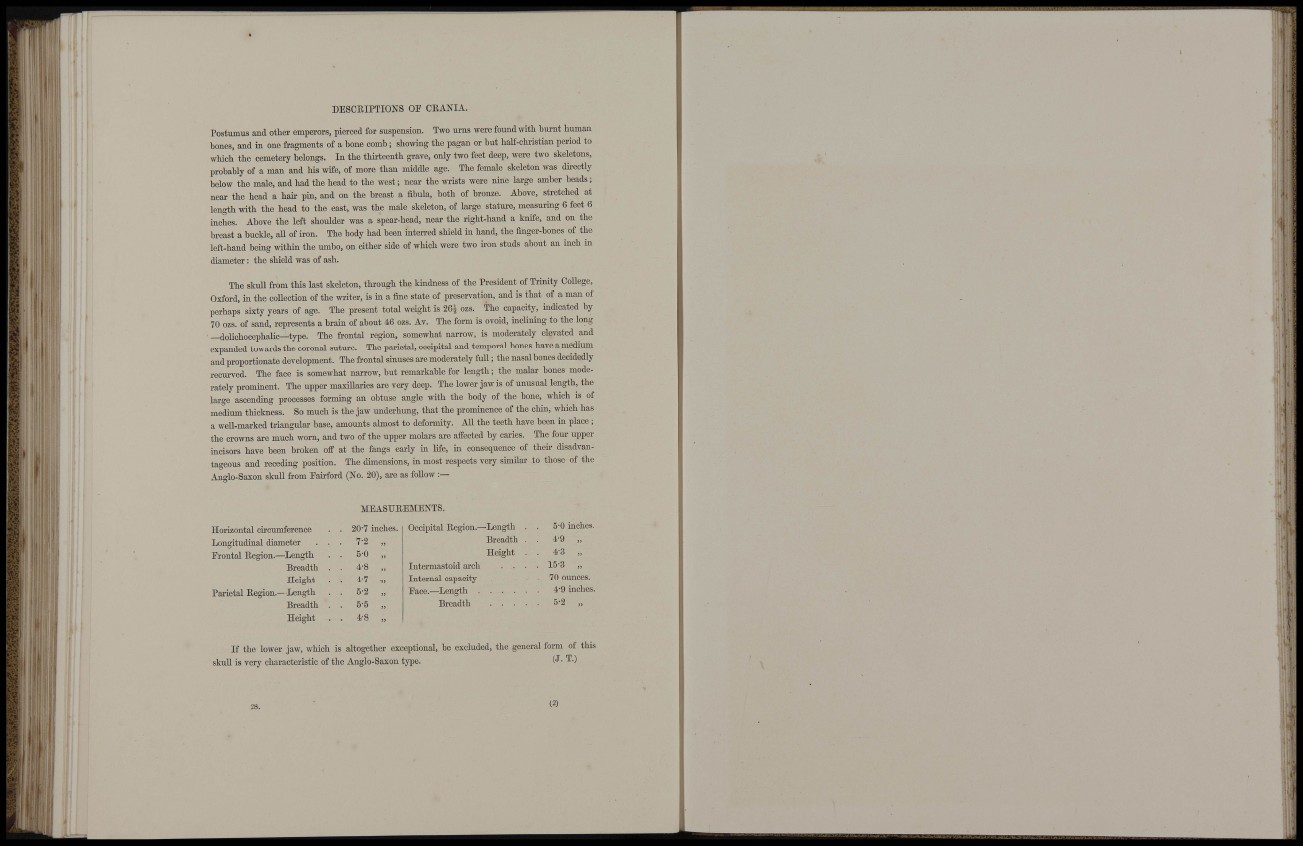
'TI
DESCRIPTIONS OE CEANIA. ^ i
m '
1
i '
ñ
Postumus and other emperors, pierced for suspension. Two m-ns were found with burnt human
bones, and in one fragments of a bone comb; showing the pagan or but half-christian period to
which the cemetery belongs. In the thirteenth grave, only two feet deep, were two skeletons,
probably of a man and his wife, of more than middle age. The female skeleton was directly
below the male, and had the head to the west; near the wrists were nine large amber beads;
near the head a hair pin, and on the breast a fibula, both of bronze. Above, stretched at
length with the head to the east, was the male skeleton, of large stature, measuring 6 feet 6
inches. Above the left shoulder was a spear-head, near the right-hand a knife, and on the
breast a buckle, aU of iron. The body had been interred shield in hand, the finger-bones of the
left-hand being within the umbo, on either side of which were two iron studs about an inch in
diameter: the shield was of ash.
The skuU from this last skeleton, through the kindness of the President of Trinity College,
Oxford, in the coUection of the wi-iter, is in a fine state of preservation, and is that of a man of
perhaps sixty years of age. The present total weight is 26i ozs. The capacity, indicated by
70 ozs. of sand, represents a brain of about 46 ozs. Av. The form is ovoid, inclining to the long
—dolichocephaUc—type. The frontal region, somewhat narrow, is moderately elevated and
expanded towards the coronal suture. The parietal, occipital and temporal bones have a medium
and proportionate development. The frontal sinuses are moderately full; the nasal bones decidedly
recurved. The face is somewhat narrow, but remarkable for length; the malar bones moderately
promiaent. The upper maxillaries are very deep. The lower jaw is of unusual length, the
large ascending processes forming an obtuse angle with the body of the bone, which is of
medium thickness. So much is the jaw underhung, that the prominence of the chin, which has
a weU-marked triangular base, amounts almost to deformity. All the teeth have been in place;
the crowns are much worn, and two of the upper molars are affected by caries. The four upper
incisors have been broken off at the fangs early in life, in consequence of their disadvantageous
and receding position. The dimensions, iu most respects very similar to those of the
Anglo-Saxon skull from Eairford (No. 20), are as foUow :—
MEASIJEEMENTS,
Horizontal circumference
Longitudinal diameter
Erontal Eegion.—Length
Breadth
Height
Parietal Region.—Length
Breadth
Height
20'7 inches.
7-2 „
5-0 „
4-8 „
4-7 „
5-2 „
6'5 „
4-8 „
Occipital Region.—Length
Breadth
Height
Intermastoid arch . .
Internal capacity . . •
Eace.—Length . . . .
Breadth . . .
5'0 inches.
4-9 „
4-3 „
15-3 „
70 ounces.
4'9 inches.
5-2 „
4
ii'l-
1 '
i.
If the lower jaw, which is altogether exceptional, be excluded, the general form of this
skuU is very characteristic of the Anglo-Saxon type. (J- T.)
28. (2)
,1 ' i
S : I (
s : '
!" 'il
îii
líl